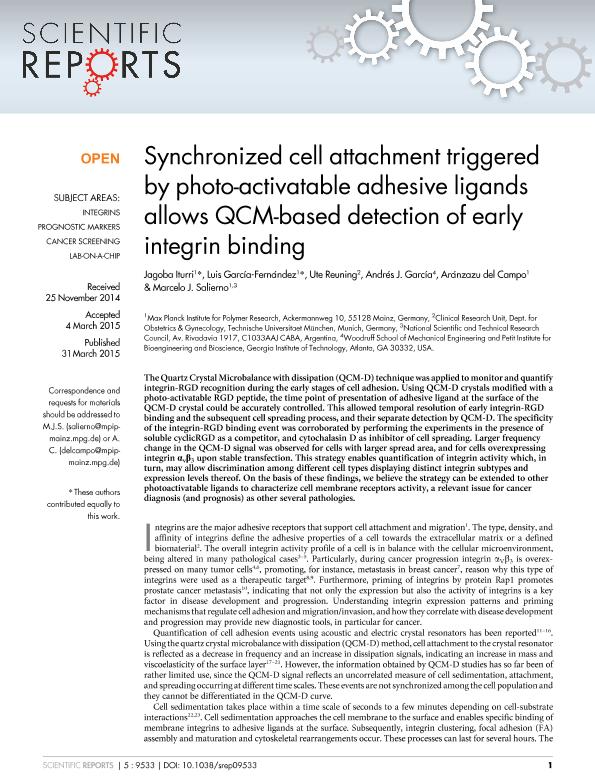Mostrar el registro sencillo del ítem
dc.contributor.author
Iturri, Jagoba

dc.contributor.author
García Fernández, Luis

dc.contributor.author
Reuning, Ute

dc.contributor.author
García, Andrés J.

dc.contributor.author
del Campo, Aránzazu

dc.contributor.author
Salierno, Marcelo Javier

dc.date.available
2017-05-18T21:34:09Z
dc.date.issued
2015-03
dc.identifier.citation
Iturri, Jagoba; García Fernández, Luis; Reuning, Ute; García, Andrés J.; del Campo, Aránzazu; et al.; Synchronized cell attachment triggered by photo-activatable adhesive ligands allows QCM-based detection of early integrin binding; Nature Publishing Group; Scientific Reports; 5; 3-2015; 1-8; 9533
dc.identifier.uri
http://hdl.handle.net/11336/16694
dc.description.abstract
The Quartz Crystal Microbalance with dissipation (QCM-D) technique was applied to monitor and quantify integrin-RGD recognition during the early stages of cell adhesion. Using QCM-D crystals modified with a photo-activatable RGD peptide, the time point of presentation of adhesive ligand at the surface of the QCM-D crystal could be accurately controlled. This allowed temporal resolution of early integrin-RGD binding and the subsequent cell spreading process, and their separate detection by QCM-D. The specificity of the integrin-RGD binding event was corroborated by performing the experiments in the presence of soluble cyclicRGD as a competitor, and cytochalasin D as inhibitor of cell spreading. Larger frequency change in the QCM-D signal was observed for cells with larger spread area, and for cells overexpressing integrin avb3 upon stable transfection. This strategy enables quantification of integrin activity which, in turn, may allow discrimination among different cell types displaying distinct integrin subtypes and expression levels thereof. On the basis of these findings, we believe the strategy can be extended to other photoactivatable ligands to characterize cell membrane receptors activity, a relevant issue for cancer diagnosis (and prognosis) as other several pathologies.
dc.format
application/pdf
dc.language.iso
eng
dc.publisher
Nature Publishing Group

dc.rights
info:eu-repo/semantics/openAccess
dc.rights.uri
https://creativecommons.org/licenses/by-nc-sa/2.5/ar/
dc.subject
Integrins
dc.subject
Cancer Screening
dc.subject
Lab-On-A-Chip
dc.subject
Cell Adhesion
dc.subject
Qcm-D
dc.subject.classification
Físico-Química, Ciencia de los Polímeros, Electroquímica

dc.subject.classification
Ciencias Químicas

dc.subject.classification
CIENCIAS NATURALES Y EXACTAS

dc.subject.classification
Química Analítica

dc.subject.classification
Ciencias Químicas

dc.subject.classification
CIENCIAS NATURALES Y EXACTAS

dc.subject.classification
Biología Celular, Microbiología

dc.subject.classification
Ciencias Biológicas

dc.subject.classification
CIENCIAS NATURALES Y EXACTAS

dc.title
Synchronized cell attachment triggered by photo-activatable adhesive ligands allows QCM-based detection of early integrin binding
dc.type
info:eu-repo/semantics/article
dc.type
info:ar-repo/semantics/artículo
dc.type
info:eu-repo/semantics/publishedVersion
dc.date.updated
2017-05-08T17:15:43Z
dc.identifier.eissn
2045-2322
dc.journal.volume
5
dc.journal.pagination
1-8; 9533
dc.journal.pais
Reino Unido

dc.description.fil
Fil: Iturri, Jagoba. Max Planck Institute for Polymer Research; Alemania
dc.description.fil
Fil: García Fernández, Luis. Max Planck Institute for Polymer Research; Alemania
dc.description.fil
Fil: Reuning, Ute. Technische Universitat Munchen; Alemania
dc.description.fil
Fil: García, Andrés J.. Georgia Institute Of Techology; Estados Unidos
dc.description.fil
Fil: del Campo, Aránzazu. Max Planck Institute for Polymer Research; Alemania
dc.description.fil
Fil: Salierno, Marcelo Javier. Max Planck Institute for Polymer Research; Alemania. Consejo Nacional de Investigaciones Científicas y Técnicas; Argentina
dc.journal.title
Scientific Reports
dc.relation.alternativeid
info:eu-repo/semantics/altIdentifier/doi/http://dx.doi.org/10.1038/srep09533
dc.relation.alternativeid
info:eu-repo/semantics/altIdentifier/url/https://www.nature.com/articles/srep09533
dc.relation.alternativeid
info:eu-repo/semantics/altIdentifier/url/https://www.ncbi.nlm.nih.gov/pmc/articles/PMC4379501/
Archivos asociados
